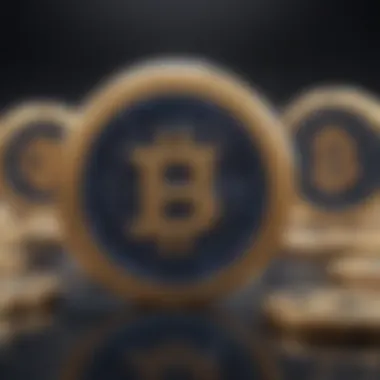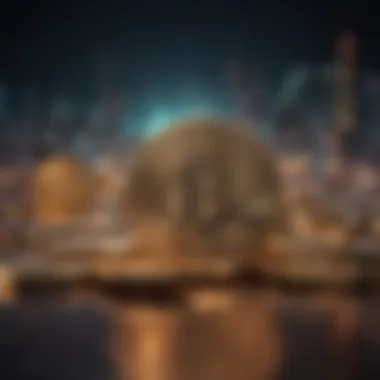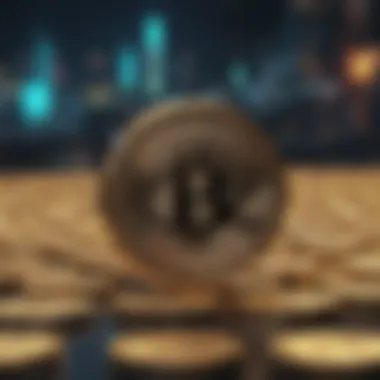The Record-Breaking World of NFTs: Most Expensive Sale


Intro
The ascent of non-fungible tokens (NFTs) has become a hot topic in recent years, stirring up discussions among investors, artists, and tech enthusiasts alike. The most expensive NFT sale marks a pivotal moment in the digital ownership landscape, unleashing waves of intrigue and speculation about the future of art and value in the digital age. In this article, we get under the hood of this phenomenon, examining not just the staggering figures involved but the underlying concepts that make such sales possible. We will also dissect its implications on the broader cryptocurrency ecosystem, giving you a comprehensive view of this ever-evolving world.
Understanding Cryptocurrency Concepts
To fully appreciate the realm of NFTs, it’s crucial to grasp some fundamental concepts surrounding cryptocurrency and digital ownership.
Blockchain Technology Explained
At the heart of NFTs lies blockchain technology. Simply put, a blockchain is a decentralized digital ledger that records transactions across a network of computers. This technology ensures that all transactions are transparent, secure, and immutable. When an NFT is sold, the transaction is verified and logged on the blockchain, providing proof of ownership and authenticity. With this, the original creator of the digital asset has their rights established, protecting their work from forgery and unauthorized use.
The concept can be likened to a public library. Just as anyone can check out a book, anyone can view the history of transactions for a particular NFT. However, ownership is maintained in a way that only the rightful owner can check it out at any given time.
Key Terms Every Investor Should Know
Navigating the NFT landscape requires familiarity with specific terminology:
- Minting: The process of creating an NFT. When an artist decides to turn a digital piece into an NFT, they are minting it, effectively registering it on the blockchain.
- Gas Fees: The costs associated with processing transactions on the Ethereum network (the most popular blockchain for NFTs). These fees fluctuate based on network demand.
- Smart Contracts: Self-executing contracts with the terms directly written into code. They automate transactions and ensure that both parties meet the agreed conditions.
- Royalties: Some NFTs are programmed to pay the seller a percentage every time the asset is resold, ensuring continued profit for the original creator.
Market Analysis and Trends
The NFT market is not just about flashy sales; it reflects larger trends within both the cryptocurrency and digital art markets. Understanding these trends can provide a roadmap for potential investors.
Current Market Trends in Cryptocurrency
In recent times, NFTs have gained traction, with marketplaces like OpenSea and Rarible becoming buzzing hubs for digital artwork. Traders are recognizing that art is just one facet of the NFT realm; collectibles, virtual real estate, and gaming assets have also come to the forefront. Investors are keenly observing these shifts:
- Increased Market Adoption: An uptick in mainstream brands joining the NFT space, partnering with artists or launching their own collections.
- Regulatory Considerations: Governments are looking into how to regulate the NFT market, which can impact investor confidence as well as trading practices.
- Cultural Impact: As global events unfold, NFTs are emerging as vehicles for social causes, with artists using their platform to raise funds for critical issues.
Investment Strategies for Different Market Conditions
Investments in NFTs require a careful approach. Here are some strategies to consider:
- Diversification: Like any investment, don’t put all your eggs in one basket. Explore different types of NFTs—combine digital art with collectibles or in-game assets for a varied portfolio.
- Research Trends: Keep a finger on the pulse of current events within the NFT market. Understanding which NFTs are gaining attention and why can give invaluable insights.
- Long-Term Vs Short-Term Investments: Consider your objectives. Are you looking for quick flips, or do you believe in holding onto a piece for potential future value?
"In this rapidly changing environment, knowledge is your ace in the hole. The more you know, the better your decisions will be."
Navigating the world of NFTs doesn’t come without its challenges, but with the right grasp on these foundational concepts, your journey in this record-breaking arena can be both enlightening and profitable.
Preamble to NFTs
In the fast-paced arena of digital innovation, non-fungible tokens, or NFTs, have sparked conversations that echo through various domains, including art, gaming, and finance. Understanding NFTs is pivotal, as they represent a groundbreaking shift in how ownership is perceived in the digital world. As this article unravels the complexities surrounding the record-breaking NFT sale, a solid grasp of what NFTs are and their significance is crucial.
The originality inherent in NFTs is what sets them apart from regular cryptocurrencies like Bitcoin. Unlike Bitcoin, which is interchangeable (or fungible) with others of its kind, an NFT is unique. They carry distinct information that validates ownership on the blockchain. This unique quality provides tangible proof of ownership for digital items, whether they be art, music, or virtual land, making NFTs immensely valuable in today's marketplace.
Moreover, the NFT space is riddled with opportunities and challenges. For investors, traders, and enthusiasts, knowing these aspects can illuminate paths for investment and engagement in the digital realm. As with any emerging technology, there are considerations to keep in mind: regulatory issues, market volatility, and the sustainability of digital ownership.
By establishing a foundational understanding of NFTs, we can now explore their technical underpinnings and market developments that shape the New Age of ownership.


Understanding Non-Fungible Tokens
Non-fungible tokens serve as the digital equivalent of unique collectibles. Picture a rare baseball card; its value is directly tied to its rarity and demand among collectors. Similarly, NFTs represent unique digital assets secured on the blockchain. This structure not only allows artists to monetize their work directly but also provides buyers with assurance of authenticity due to the immutable nature of blockchain technology.
To elaborate, when someone purchases an NFT, they acquire a digital certificate, embedded in the blockchain, that attests to the asset's uniqueness and ownership. Artisans, musicians, and game developers have all embraced this technology, with the ability to create, sell, and trade their works in an unprecedented way.
The Technological Backbone: Blockchain
At the heart of the NFT phenomenon lies blockchain technology, which facilitates transparency, security, and trust. Essentially, a blockchain is a decentralized digital ledger that records transactions across multiple computers. Each block in this chain contains a set of transactions that are cryptographically linked, ensuring security and integrity.
Utilizing blockchain, NFTs establish their uniqueness and ownership through -
- Smart Contracts: These are self-executing contracts with terms of the agreement between buyer and seller directly written into code. This eliminates the need for intermediaries, streamlining the buying process.
- Decentralization: Unlike traditional databases controlled by a single entity, blockchains are distributed across numerous nodes, minimizing risks of breaches or failures. This feature enhances the security of digital assets significantly.
The Market Landscape
Understanding the market landscape is crucial when exploring the world of NFTs, especially in regard to sales that shatter records. At its core, the market forms the setting where digital assets are traded, valued, and appraised, allowing both creators and collectors to engage in a vibrant ecosystem. With the rise of NFTs, we’ve not only witnessed a surge in digital art sales, but also significant shifts in how value is perceived in the art world and beyond.
The importance of this topic lies in several key aspects:
- Demand and Supply Dynamics: The market reflects how the interaction between demand and supply influences prices. Major sales can signal increasing demand for digital assets, drawing in investors from various sectors.
- Market Trends: Understanding the trends within this landscape can help predict future developments. For instance, if certain styles or mediums of NFTs become popular, the entire market may shift in response.
- Investment Strategies: Investors need to grasp the market landscape to make informed decisions. Knowing who the active players are or which platforms are gaining popularity affects strategies for buying and selling.
In short, this landscape acts as a lens through which we can assess the value and sustainability of NFTs in today’s economy.
Growth and Popularity of NFTs
NFTs have experienced an explosion in growth over recent years, reflecting a shift in both cultural and economic paradigms. The initial novelty has matured into a full-fledged interest from both creators and investors, converging to create high demand.
From digital artists experimenting with new mediums to established brands entering the space, the growth appears almost exponential. Notable events, such as high-profile sales, have caught media attention, drawing in curious individuals who might be new to the digital asset game. Traditional auctions now feature NFTs, signaling a legitimization of their value.
Additional factors contributing to this popularity include:
- Accessibility: Platforms like OpenSea and Rarible have made it easy for anyone to mint and trade NFTs. As a result, entry barriers are lowered.
- Celebrity Involvement: The involvement of celebrities and influencers has added a layer of excitement, often accelerating interest among their fanbases.
- Community Engagement: Social media has played a central role in promoting NFTs. Artists and collectors actively share their journeys online, creating a sense of community.
All these elements create an ecosystem ripe for exploration and investment, offering countless opportunities for enthusiasts.
Key Players in the NFT Marketplace
In any market, knowing the key players can provide invaluable insights. The NFT space is no different. The following groups collectively shape the NFT marketplace:
- Artists and Creators: They are the lifeblood of the NFT ecosystem. New and seasoned artists alike use NFTs as a vehicle for their works, breathing new life into digital art.
- Marketplaces: Platforms like Nifty Gateway, Foundation, and SuperRare facilitate the buying and selling process, offering unique features and communities.
- Investors and Collectors: Individuals or groups who see NFTs as an investment opportunity or simply want to collect digital artworks drive demand.
- Brokers and Consultants: This emerging group provides guidance for new entrants, helping them navigate the complexities of valuation and the sales process.
- Brands and Corporations: Major companies leverage NFT technology for marketing and brand loyalty, creating experiences further enhancing consumer engagement.
This diverse ecosystem illustrates how all these factions interact, influencing the larger market dynamics and driving the NFT narrative forward.
Historic Sales in the NFT Space
The realm of non-fungible tokens (NFTs) has swiftly morphed into a bustling market that flaunts historic sales as hallmarks of its growth. The concept of digitizing ownership through art and collectibles might have sounded far-fetched just a few years back, yet it's these very transactions that now hammer home the value of NFTs. Understanding historic sales not only enriches insight into the market's dynamics but also shines a light on the shifting paradigms of ownership and creativity.
Focusing on significant sales allows investors and enthusiasts alike to see what kind of digital assets resonate most within the community. Exploring these record-setting sales offers vital clues about demand trends. Why did a certain piece sell for millions while others barely garnished attention? Tracking these transactions unveils the underlying motivations and societal implications surrounding the growing acceptance of digital assets. In a world where traditional value is constantly questioned, historic sales become more than mere numbers; they embody a shift in how art and ownership are perceived.
Tracking Significant NFT Sales


Diving into the records of NFT sales provides a treasure trove of insights that go beyond what first meets the eye. A pivotal moment for the NFT market was the landmark sale of Beeple’s “Everydays: The First 5000 Days,” which fetched an astounding $69 million at Christie’s auction in March 2021. This moment crystallized the idea that digital artwork could command prices on par with classical masterpieces.
- Impact of Notable Sales: Each significant sale sends ripples through the NFT community. When a piece sells for a staggering amount, it often leads to an influx of new interest from both investors and creators. Consequently, this dynamic fuels market growth, creating an ecosystem ripe for opportunities.
- Tracking Mechanisms: Keeping an eye on platforms like OpenSea or Rarible helps to monitor sales trends. Data analytics tools can also offer a granular perspective on such transactions, giving stakeholders insight into buyer preferences and emerging trends. This information is invaluable for making informed investment decisions or for artists seeking to position their works.
- Community Engagement: Also, high-profile sales often generate discussions across social media platforms. Communities on Reddit and Facebook buzz with theories about buyer motivation and potential resale value. Engaging with these platforms provides context to the numbers, helping to decode what they mean in a wider scope.
The Role of Auctions in NFT Sales
Auctions play a central role in the landscape of NFT sales, acting as both a beacon and a battleground for digital art enthusiasts. Unlike traditional sales, where pricing may be fixed, auctions allow for a dynamic interplay between bidders, driving up the final value based on demand.
- Competitive Environment: The excitement of bidding creates an atmosphere that can significantly bolster a piece’s value. Potential buyers often find themselves in a bidding war, driven not just by the asset’s perceived worth but also by the thrill of the chase. Such competition can inflate prices dramatically, making auctions a pivotal marketplace for digital assets.
- Notable Auction Houses: Major auction houses like Sotheby's and Christie's have embraced the NFT movement, leveraging their reputation and networks. By hosting high-stakes auctions, they validate the market and attract high-profile collectors. Their involvement showcases a shift in traditional art auctioning practices, echoing the adaptability required in today’s digital world.
- Transparency and Trust: Auctions often come with a sense of transparency. Potential buyers can see how much others are willing to pay, offering a clearer picture of market value. This transparency breeds trust, which is crucial in a market that can sometimes feel nebulous.
The record-breaking sale of a digital asset isn't merely a number; it's a reflection of societal shifts, a testament to innovations in digital ownership, and an invitation into an expanding universe of possibilities.
In sum, understanding historic sales and the mechanics of auctions equips investors and enthusiasts with a more nuanced view of the NFT landscape. By navigating the ebb and flow of these transactions, one can glean insights not just into the value of digital tokens but also into the broader conversation about art, ownership, and the future.
The Most Expensive NFT Sale
The phenomenon surrounding NFTs has sparked conversations that ripple through finance, art, and even technology sectors. Among the many stories that emerge from the NFT universe, none are as bewitching or significant as that of the most expensive NFT sale. This sale stands as a testament to what can happen at the intersection of art and digital ownership. Here, we’ll peel back the layers of this record-breaking event, discussing not just the asset itself, but also its implications on the realm of NFTs.
Overview of the Record-Breaking Digital Asset
At the crux of this discussion lies the digital artwork titled Everydays: The First 5000 Days, created by the artist known as Beeple. This stunning piece stitched together a collection of his daily digital art creations over the course of nearly 14 years. It’s a collage that not only signifies the artistic talent of Beeple but also encapsulates the evolution of digital art.
Everydays isn't just another image in the vast expanse of the Internet; it represents a unique moment in time and creativity, forever marked on the blockchain. It embodies the convergence of top-tier art and cutting-edge technology. This particular NFT was sold for a whopping $69 million at a Christie’s auction, shaking the very foundations of both the art world and the NFT marketplace. A figure like that sends ripples throughout various communities—it’s more than just a sale, it’s a pivotal point in digital history.
Details of the Sale: Who, What, When
The event took place on March 11, 2021, and was a game-changer. Christie’s, a well-respected auction house, broke the mold by accepting cryptocurrency for the purchase—a risky move that underscored the growing acceptance and validation of digital currency. The buyer, a cryptocurrency investor and founder of Metakovan, placed the winning bid after fierce competition.
- What: Beeple's Everydays: The First 5000 Days
- Who: Metakovan, a prominent figure in the tech community
- When: March 11, 2021
The auction tallied several bidders, each pushing the price higher and higher. The atmosphere was charged, both for the art world and the crypto enthusiasts watching from the sidelines. What made this event particularly interesting were the signifiers of value in the digital asset space—essentially redefining what is considered valuable in art.
The Buyer: A Profile
Metakovan, whose real name is Vignesh Sundaresan, isn't just the typical art collector. An investor in digital assets and a staunch supporter of the NFT movement, Sundaresan has a vision for what NFTs can accomplish beyond mere monetary value. His purchase of Everydays paints him as an influential player in the growing NFT scene, which provide a new framework of ownership in a digital age.
His intentions radiate deeper than investing in art; he dreams of utilizing NFTs to enable artists to gain fair compensation and to amplify voices that often go unheard.
"It's not just about owning a piece of art, it's about empowering a generation of creators who will redefine our future through digital ownership"
—Vignesh Sundaresan
This purchase ultimately represents a shift—a blend of technology, culture, and investment—a trifecta that fuels the future of many art forms.
In summary, the story of the most expensive NFT sale isn’t merely about the price; it ideates on the future contours of ownership, value, and what it means to own a piece of art in the digital era. Understanding this framework is vital for investors, analysts, and enthusiasts alike, as we navigate through an ever-changing landscape.
Implications of the Sale
The sale of the most expensive NFT has shaken up the very foundation of the digital marketplace, leaving an indelible mark on various facets of the NFT ecosystem. Understanding these implications is crucial for investors, collectors, and creators alike, as they navigate this fascinating yet volatile domain. Factors such as market dynamics, potential regulatory changes, and societal views are now in a constant state of flux, influenced largely by this record-setting transaction.
Impact on the NFT Market


The ripple effect from this sale can be seen across the entire NFT market landscape.
- Heightened Investor Interest: The eye-popping price tag has attracted a swarm of new investors eager to get a slice of the action. For many, it’s a gold rush, but one that comes with its fair share of risks. The market has witnessed a significant uptick in both buyers and sellers, causing a surge in trading volume across platforms.
- Price Speculation: This monumental sale has prompted rampant speculation on price valuation for upcoming NFTs. Many creators might inflate their estimations, hoping to achieve similar success. That creates a tricky dynamic. Prices could see stark fluctuations as buyers and sellers jockey for position.
- Accelerated Innovation: The attention paid to high-value NFTs invites a wave of creativity. Artists and developers are now charged with pushing the envelope in terms of design and functionality. This can lead to more engaging and diverse offerings, which, in turn, could attract broader audiences.
However, it would be unwise to ignore the downside risks. An overheated market could mean a bubble on the verge of bursting, leading to severe financial repercussions for unsuspecting participants. The lesson here is that much like any investment, especially in digital assets, it pays to tread carefully.
Cultural Significance of High-Value NFTs
High-value NFTs are not just digital assets; they represent a shifting cultural paradigm in how we view ownership and creativity.
- Artistic Validation: The record-breaking sale serves as a validation for digital artists, often dismissed compared to their physical counterparts. It places digital art on the same pedestal as traditional art forms, commanding respect and, importantly, financial compensation.
- Changing Ownership Dynamics: Ownership is no longer confined to the physical realm. The controversies surrounding copyright, originality, and authenticity become increasingly prominent. When a digital item is bought as an NFT, it’s not just property being exchanged; it's the recognition of the creator's effort and intellectual property.
- Community and Social Ramifications: High-value NFTs also foster a sense of community among collectors and enthusiasts. They often feel a connection to not just the artwork, but to the story behind it. Engaging in discussions on platforms, sharing insights on subreddits like r/NFT, or celebrating community-driven initiatives reflects a new wave of social interaction powered by digital ownership.
As the dust settles from the sale, one thing is clear: it’s about more than just a hefty price tag; it encapsulates a transformation in our culture and how we define value in the digital age.
In the digital world, ownership is an evolving concept that intertwines technology, creativity, and community, defying conventional boundaries.
Trends and Predictions
As we look to the future of NFTs, it’s clear that understanding this space involves more than just keeping an eye on current sales. The trends and predictions surrounding NFTs matter immensely for investors, traders, analysts, educators, and enthusiasts alike. These aspects not only shape the market dynamics but also help in discerning potential areas of innovation and investment.
Future of NFTs and Digital Art
When it comes to the trajectory of NFTs, digital art remains at the forefront. Artists are leveraging this technology to redefine expressions of creativity and ownership. Unlike traditional art, where physical pieces dominate, the digital medium offers endless possibilities:
- Accessibility: Digital art can reach collectors worldwide without geographical constraints. This opens doors for lesser-known artists.
- Transparency: With blockchain, every transaction can be traced back, providing proof of authenticity which is vital in the art world.
- Interactivity: Digital art has opportunities that physical art does not. For instance, creators can design NFTs that change over time or react to viewer interactions.
However, the future isn't without its challenges. As the interest grows, so does the competition. It remains to be seen which platforms will emerge as leaders, whether through technology or community engagement. The digital art revolution is thrilling, yet it requires constant adaptability from participants.
Potential Regulatory Challenges
Navigating the NFT landscape isn’t all sunshine and rainbows; regulatory challenges loom large. As governments worldwide begin to take notice of digital ownership, several key factors surface:
- Tax Implications: How will transactions be taxed? The classification of NFTs as assets raises questions about capital gains and ownership.
- Copyright Issues: The delicate balance between ownership and rights must be addressed. Who truly owns the rights to an NFT? The creator, the buyer, or both?
- Consumer Protection: As bad actors emerge in the market, providing security for buyers becomes paramount. Regulations that protect consumers could reshape the NFT platform landscape.
The future might hold frameworks aimed at resolving these issues, but it remains a mixed bag of uncertainty and opportunity. Those involved may want to stay ahead of potential developments to strategize appropriately.
In summary, keeping an eye on trends and understanding possible regulatory challenges equips stakeholders with insights crucial for navigating the evolving NFT ecosystem.
End: The Evolution of Digital Ownership
The world of digital ownership has transformed remarkably with the rise of non-fungible tokens (NFTs). This evolution marks a fundamental shift in how we understand value and ownership in the digital realm. The mere fact that a digital asset can fetch millions reflects a new paradigm of ownership that transcends traditional concepts of art and collectibles. NFTs allow individuals not just to buy but to truly own unique digital items, which is a game changer in a society increasingly driven by digital interaction.
As we look at the implications of this evolution, it's crucial to recognize several aspects:
- Authenticity and Verification: NFTs inherently provide proof of ownership, thanks to their foundation on blockchain technology. This is a stark contrast to the physical art world, where provenance issues can muddy the waters. With NFTs, buyers can trace the history of the asset, fostering greater trust.
- New Economic Models: The rise of NFTs has birthed economic structures that allow creators to capture value directly. Artists can earn royalties on resales, fundamentally changing how they benefit from their work. This reconsideration of revenue streams is something that can benefit creators across various industries.
- Cultural Significance: High-value NFTs challenge the traditional definitions of art and ownership, especially as they gain recognition in conventional auction houses and galleries. The embrace of digital assets signifies a shift in cultural attitudes towards what constitutes valuable art and who gets to own it.
This dynamic nature of digital ownership emphasizes the importance for investors, traders, and enthusiasts alike to stay abreast of the continually shifting landscape. Understanding NFTs isn't merely about investing in digital images or virtual real estate; it's about grasping the larger narrative of how our society is redefining value itself.
"The merging of digital and physical ownership realms raises questions about the future, invariably pushing the boundaries of creativity and commerce forward."
Final Thoughts on NFT Value and Society
The questions about the true value of NFTs are complex and multilayered, similar to the shifting sands of a desert. Are they mere digital novelties or gateways to a new economic frontier? As society grapples with this notion, we must consider various factors that play into the value of NFTs:
- Scarcity versus Accessibility: NFTs boast a unique trait of scarcity that can drive up their perceived value. However, that brings forth the dilemma of accessibility—not everyone can afford to buy high-end NFTs, which could create a digital divide.
- Evolving Cultural Perspectives: As digital ownership becomes more mainstream, societal views might shift regarding the significance of owning digital assets. The evolution of trends will shape the future demand for NFTs and their cultural weight.
- Market Speculation: Speculative behaviors can significantly influence NFT valuations. Some investors may treat these assets like stocks, leading to volatile market conditions that could either propel or undermine their legitimacy.
In summary, the evolution of digital ownership via NFTs demonstrates a unique intersection of technology, art, and finance. Navigating this complex terrain demands an informed perspective, urging stakeholders to engage with the ethical implications and potential of this digital revolution.















